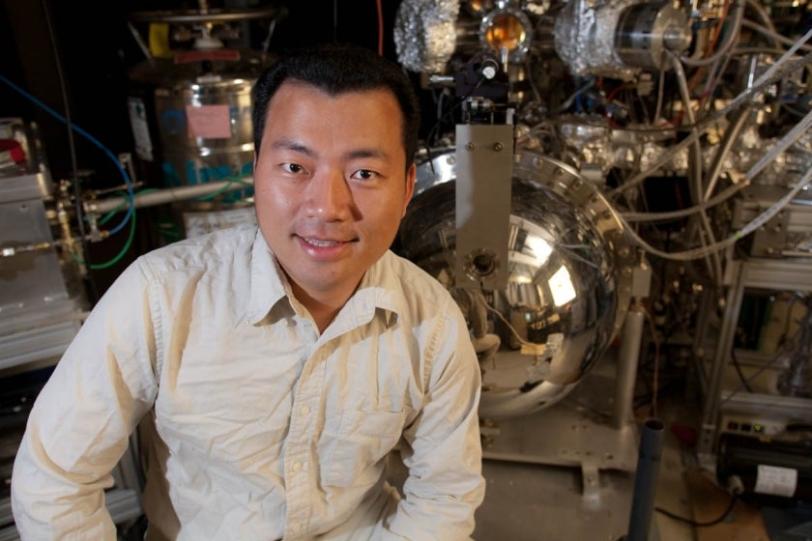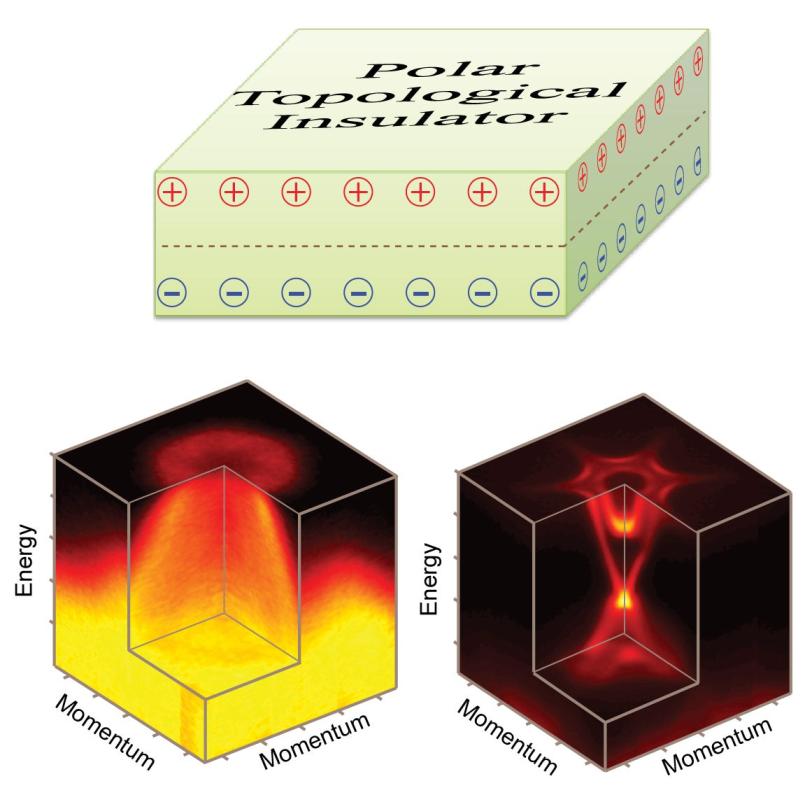A New Topological Insulator Breaks Symmetry, and That's a Good Thing
Scientists working at SLAC, Stanford, Oxford, Berkeley Lab and in Tokyo have discovered a new type of quantum material whose lopsided behavior may lend itself to creating novel electronics.
By Glennda Chui
Scientists working at SLAC, Stanford, Oxford, Berkeley Lab and in Tokyo have discovered a new type of quantum material whose lopsided behavior may lend itself to creating novel electronics.
The material is called bismuth tellurochloride, or BiTeCl. It belongs to a class of materials called topological insulators that conduct electrical current with perfect efficiency on their surfaces, but not through their middles. Researchers hope to exploit their unusual properties to create “spintronic” devices that use the electron’s spin, rather than just its charge, to carry energy and information with 100 percent efficiency and at room temperature.
In an advance reported Oct. 6 in Nature Physics, a team led by Yulin Chen of the University of Oxford discovered a material made of many layers of BiTeCl and showed that it lacks symmetry in one important respect: Electrical current flows differently along its top surface than along its bottom.
Scientists have hoped to create such asymmetric topological insulators for use in novel room-temperature devices, said Chen, who was a staff scientist at SLAC when the experiments began. Although that practical goal is still far away, he said, this is an important step forward.
In conventional electronic chips, two types of semiconducting materials come together to form transistors and diodes. N-type semiconductors have an excess of electrons and are highly conductive. P-type materials are electron-depleted, leaving positively charged “holes” where the electrons used to be. Where these two types of materials meet in a “p-n junction,” electrons flow from the n to the p layer in a robust one-way current.
Most topological insulators operate as either a p-type or n-type material on both top and bottom surfaces. But BiTeCl is asymmetric: p-type on its top surface and n-type on its bottom. This means the edges of the material could function as p-n junctions – or even many microscopic p-n junctions layered on top of each other. Even better, when the material is placed in a magnetic field, these p-n junctions develop unique edge channels that can conduct electricity with zero resistance, Chen said – and this opens all sorts of possibilities.
Moreover, this unique type of material can demonstrate many other phenomena. For instance, placing it in a static electric field can induce useful magnetic properties in the material, a phenomenon known as the topological magneto-electric effect, first predicted by theorist Shoucheng Zhang of the Stanford Institute for Materials and Energy Sciences and his group. You could even use an electric charge to induce magnetic monopoles – theorized magnets that have just one pole, north or south, rather than the usual two – and then use this exotic magnetic state to do practical work, such as storing information on a hard drive, Chen said. “This is very bizarre,” he said, “because people have never found magnetic monopoles as fundamental particles.”
To do that, theorists say, the material would have to violate two fundamental symmetries: the one violated by BiTeCl in this study, which is known as inversion symmetry, and time reversal symmetry, which says a process should look the same going forward or backward in time. Breaking both symmetries at once is difficult, Chen said; for example, it requires applying a magnetic field perpendicularly but in opposite directions on the top and bottom of a thin film. But now that scientists have made a material that breaks the first symmetry, it will be straightforward to break the second one.
For this study, scientists at the Tokyo Institute of Technology crafted BiTeCl from many alternating layers of bismuth, tellurium and chlorine. It was tested in Stanford University laboratories and at two X-ray light sources – SLAC’s Stanford Synchrotron Radiation Lightsource and Lawrence Berkeley National Laboratory’s Advanced Light Source.
Researchers hit samples of the material with an X-ray beam, and then used a technique called ARPES to measure the energy and momentum of electrons the beam kicked out of the material. This gave them a clear picture of the material’s electronic state.
"The discovery of this new, asymmetric topological insulator will introduce many new phenomena we are looking for, and provide possibilities for device applications,” said SLAC and Stanford graduate student Zhongkai Liu, who participated in the experiments.
The next step, Chen said, is to purify and improve the material and make high-quality thin films for experiments that try to produce and study the topological magneto-electric effect.
The research team also included Zhi-Xun Shen, a professor at SLAC and Stanford and SLAC’s advisor for science and technology; Zahid Hussain, senior staff scientist at Berkeley Lab; and other researchers from SLAC, Stanford, Berkeley Lab and Tokyo Institute of Technology. The study was partially funded by the U.S. Department of Energy’s Office of Basic Energy Sciences.
Citation: Y.L. Chen et al, Nature Physics, 6 October 2013 (10.1038/nphys2768)
Related links
- SLAC/Stanford Scientists Make First Direct Images of Topological Insulator's Edge Currents
- SLAC, Stanford Materials Scientists Develop Topological Insulator With a Switch
- Shoucheng Zhang, Stanford Physicist and SIMES Scientist, Honored by American Physical Society
- Science Breakthrough of the Year 2007 Runners-up: Electrons Take a New Spin







